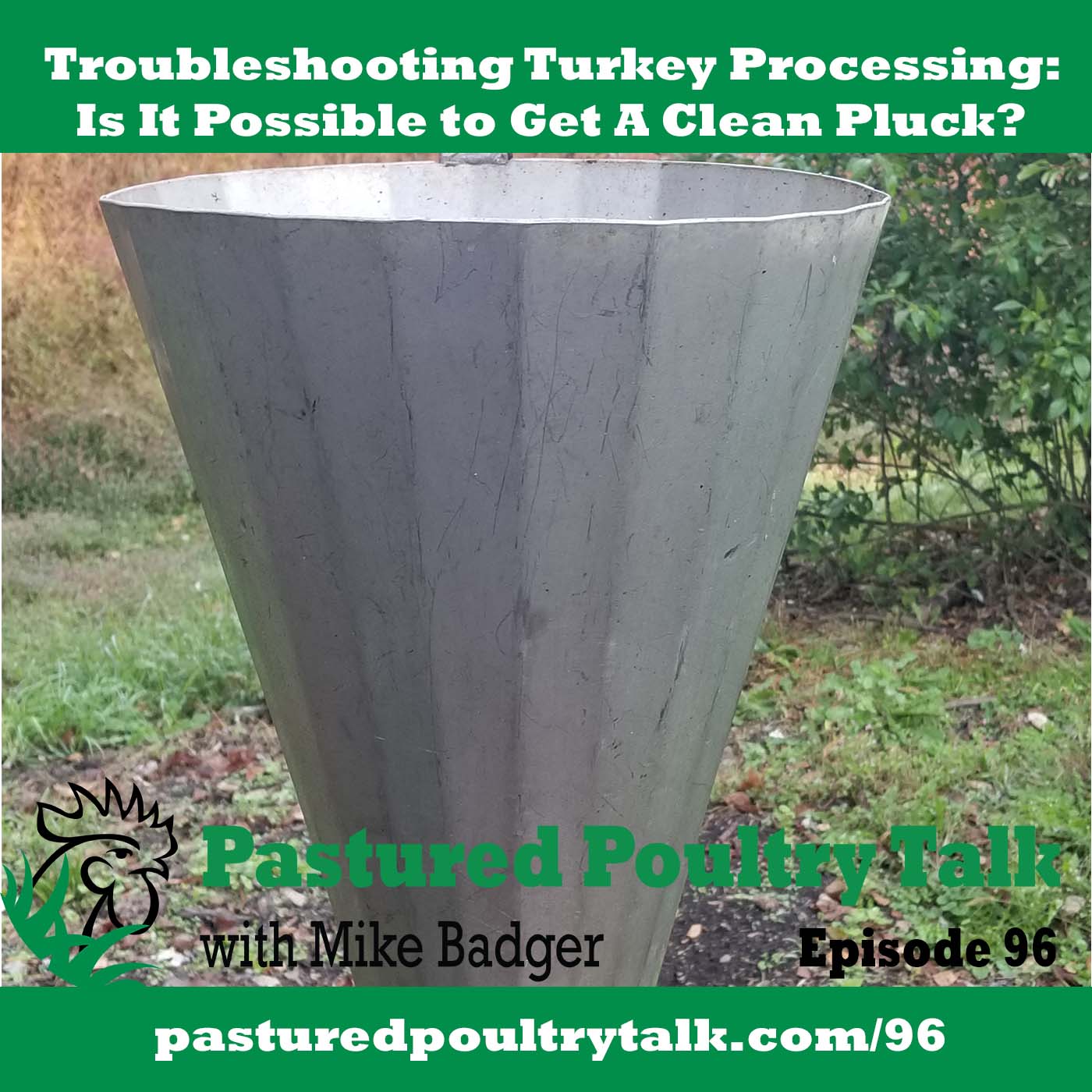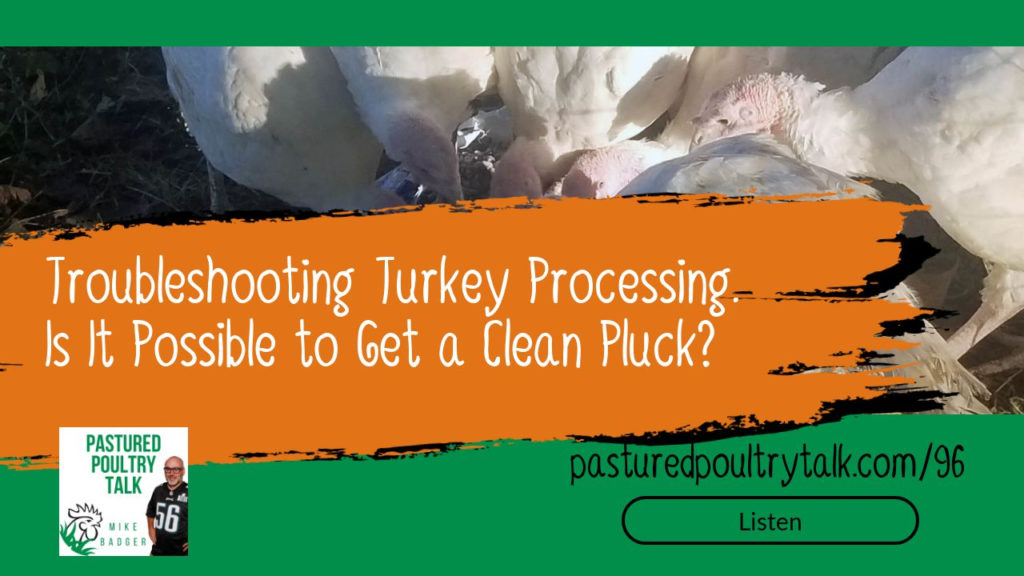

[podcast src=”https://html5-player.libsyn.com/embed/episode/id/11605961/height/90/theme/custom/thumbnail/yes/direction/forward/render-playlist/no/custom-color/88AA3C/” height=”90″ width=”100%” placement=”top” theme=”custom”]This is an edited version of the article I published in Issue 113 of the APPPA Grit, which was based on the conversation in this podcast. Not a member of APPPA? Go check them out.
Last fall, I had the pleasure of consulting with a producer on some questions about his farm’s turkey processing procedure. Since turkey processing season 2019 is fast approaching, I wanted to share some highlights of that conversation in this podcast. One of the biggest challenges with the turkey processing was the amount of hand plucking required to finish the birds. The hand plucking went anywhere from five to ten minutes extra. The natural question becomes, “can I pluck the turkeys clean like I do with chickens?” I had this same conversation with a different person recently, so I know it’s a relatively common question. The first place to troubleshoot this type of problem is the scalder.
The farm I was talking to was scalding and plucking four turkeys that dressed between 16 and 20 pounds in a Poultry Man 41” scalder and a Featherman XL plucker. Due to problems with the turkeys catching in the rotating platform of the scalder, the farm was manually dunking 4 turkeys in the rotary scalder (the platform was stationary and vertical). Then in the plucker, the birds were getting jammed up. One person actually had to man the plucker.
Maintain Water Temperature and Level
When scalding anything, it helps to ensure your scalder maintains the water temperature as you process. My scalder has one 65,000 BTU burner, and for turkeys, I need to heat supplemental water because I can process turkeys faster than the water recovers. The temperature recovery problem is compounded because the turkeys remove a lot of water from the scalder, so it’s not just heating up water that has cooled ten degrees, it’s heating up larger quantities of cold water. In addition to maintaining temperature, make sure you keep the water level full.
Stop Dunking Birds Up and Down
For the processors using a manual scalding approach, the first piece of advice I always give is to stop dunking birds up and down. This enables a bad scald. Basically, the breast gets more scald than the legs and thighs, so it’s uneven.
If you are manually scalding, try dropping the birds into the scald water and then stir them like soup. Test your scald early and often because the birds will scald faster with this approach, but they will be consistent. Plucking will be a pleasure, even by hand. This process works for heritage birds, too. I remember processing at a farm in North Carolina a few Thanksgivings ago; I ran the manual scalder and there was no dunking involved, and my back was appreciative.
If you’re using a rotary scalder, there’s no reason to hand dunk. Adjust the volume of birds to flow through the system efficiently. In the case of rotary scalders, you can often increase your throughput by scalding birds on both sides of the rotating rack.
Remove Feet and Point Necks In
On the scalder, I recommend taking the feet off the turkeys prior to scalding (which the farm was doing) and loading the turkeys so that the necks point into the center of the tank, not the sides. Sometimes with scalders that have a gap between the rotating platform and the sides of the scalder, the long turkey necks find a way to slide into that gap.
Add the Right Number of Birds to the Plucker
The goal of the plucker is to have enough birds so that they tumble against each other; otherwise, the plucking requires a human hand to make the birds tumble or the feathers won’t pick off. However, there is often another problem we don’t think about in the plucker, and that’s too many birds. My recommendation during the podcast was was to put three turkeys into that 32″ diameter plucker instead of four. This gives the birds room to go around the drum and still tumble into each other.
I had the pleasure of the hearing back from the farm after their 2018 turkey processing, and the tips I shared greatly helped process the nearly 500 turkeys. They confirmed that three turkeys through the plucker was the optimum number.
If you’re using a smaller scalder and plucker, your batch size may be limited to one or two turkeys at a time. If you’re using a 22” or 23” plucker, you’re likely limited to one turkey. If you move up to a 27” diameter plucker, you have one tom or two hens, if we’re talking about broad breasted whites.
It’s incredibly hard to pluck one turkey efficiently. It will take somebody babysitting the plucker to keep the turkey tumbling. And even in the smaller diameter pluckers of less than 30”, two turkeys will find a way to jam up frequently. Again, it needs a babysitter. Don’t fight it. Accept it. And if you’re doing more than a few dozen turkeys at any one processing, you’ll get a lot of improvement with a 32” or 35” or larger plucker and a scalder to match.
Wrap-Up
You’ll notice that most of the solutions to a poor pluck do not focus on the plucker. This is why you sometimes need somebody to talk through issues with you. We obsess over efficiency, especially processing line throughput to the point where we only see bigger batches as the solution.
Cleanly plucking three turkeys at a time with no hand plucking will pencil out more efficiently every time compared to running four turkeys that require ten minutes of hand plucking. All the commercial scalders and pluckers should make your turkey featherless with little work from you. If that’s not your experience, troubleshoot, and invest in the proper equipment, if needed.
